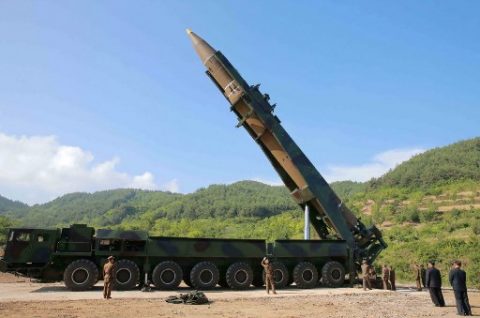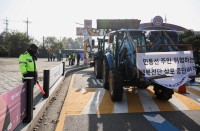
North Korea declared on July 4 it had successfully tested its first intercontinental ballistic missile — a watershed moment in its push to develop a nuclear weapon capable of hitting the mainland United States. / AFP PHOTO /
SEOUL, South Korea (AFP) — North Korea launched a ballistic missile over Japanese territory on Tuesday, in a surprise move that ramped up international alarm over its weapons program.
Here are the key dates in Pyongyang’s quest to develop a missile capable of hitting the United States:
Late 1970s: North Korea starts working on a version of the Soviet Scud-B (range 300 kilometres or 185 miles). Test-fired in 1984
1987-92: Begins developing variant of Scud-C (range 500 km), Rodong-1 (1,300 km), Taepodong-1 (2,500 km), Musudan-1 (3,000 km) and Taepodong-2 (6,700 km)
Aug 1998: Test-fires Taepodong-1 rocket over Japan in what it calls a satellite launch — the US and others say it is a missile
Sept 1999: Declares moratorium on long-range missile tests amid improving ties with US
July 12, 2000: Fifth round of US-North Korean missile talks ends without agreement after North demands $1 billion a year in return for halting missile exports
March 3, 2005: Pyongyang ends moratorium on long-range missile testing, blames Bush administration’s “hostile” policy
July 5, 2006: Test-fires seven missiles, including a long-range Taepodong-2 which explodes after 40 seconds
Oct 9, 2006: Conducts underground nuclear test, its first
April 5, 2009: Launches long-range rocket which flies over Japan and lands in the Pacific, in what it says is an attempt to put a satellite into orbit. The United States, Japan and South Korea see it as a disguised test of a Taepodong-2
May 25, 2009: Conducts its second underground nuclear test, several times more powerful than the first
April 13, 2012: Launches what it has said is a long-range rocket to put a satellite into orbit, but which disintegrates soon after blast-off
December 12, 2012: Launches a multi-stage rocket and successfully places an Earth observational satellite in orbit
February 12, 2013: Conducts its third underground nuclear test
January 6, 2016: Conducts its fourth underground nuclear test, which it says was a hydrogen bomb — a claim doubted by most experts
March 9, 2016: Kim Jong-Un claims the North has successfully miniaturised a thermo-nuclear warhead
April 23, 2016: Pyongyang test-fires a submarine-launched ballistic missile
July 8, 2016: US and South Korea announce plans to deploy an advanced missile defence system — THAAD (Terminal High Altitude Area Defense)
August 3, 2016: North Korea fires a ballistic missile directly into Japan’s maritime economic zone for the first time
September 9, 2016: Conducts fifth nuclear test
March 6, 2017: Fires four ballistic missiles in what it says is an exercise to hit US bases in Japan
March 7, 2017: US begins deploying THAAD missile defence system in South Korea
May 14, 2017: North Korea fires a ballistic missile which flies 700 kilometres before landing in the Sea of Japan. Analysts say it has an imputed range of 4,500 kilometres (2,800 miles) and brings Guam within reach
July 4, 2017: Test-fires a ballistic missile that analysts say brings Alaska within reach. Pyongyang later says it was a “landmark” test of a Hwasong-14 intercontinental ballistic missile (ICBM)
July 28, 2017: Launches a missile with a theoretical range of 10,000 kilometres, meaning it could hit much of the United States
August 26, 2017: Fires three short-range ballistic missiles
August 29, 2017: Fires ballistic missile across Japanese territory. South Korea says it was launched from Sunan, near Pyongyang and flew around 2,700 kilometers at a maximum altitude of around 550 kilometers.
© Agence France-Presse








